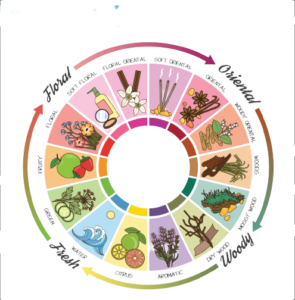Create Your Own Perfume with The Fragrance Wheel

Exclusive perfumes do not get made in a day. Trying to get the perfect blend by adding some of the finest and richest essential oils takes time. After many trials and errors, the perfumers come up with perfumes that make everyone captivated.
For creating the perfect mixture, one must learn about the fragrance wheel. There are thousands of aromatic elements that are used in creating perfumes. Without the knowledge of what comes from where and what goes with what, one might not get the expected results.
What is the Fragrance Wheel?
It’s a circular diagram that represents the connection between different fragrances families. Michael Edward, an expert perfumer, invented this wheel of fragrances. He developed this circular diagram for the retailers and consumers of perfumes.
In this wheel, the scents are categorized into four families, which again are divided into subcategories. Some subclasses cannot be totally separated as one fragrance blends into the next one having characteristics of both fragrance families.
4 Fragrance Families
You cannot say first, and last fragrance family as the wheel goes in a cyclic way, and you consider any of the four as the first. Therefore, we have started with the floral family. Respectively comes the oriental family, woody family, and fresh family.

1. Floral Fragrances
The prominent scent from this fragrance family is floral. The scent from this family can come out as fruity, as fruity notes also belong to this family. This family can be divided into four subfamilies.
Fruity
As the name suggests, perfume essence or essential oils that are extracted from fruits belong to this family. However, not all fruits, only sweet fruits, are in this category. This category owns the fragrances of apples, peaches, pineapple, etc.
Floral
Fresh-cut flowers are simply what makes this subfamily. Any flower that has a beautiful scent and is used in perfumery belongs to this subfamily. Rose, jasmine, lilies are only a few names of this category.
Soft Floral
Flowers with a soft and powdery smell are placed in this subfamily. Flower-like iris, heliotrope, violet gives a soft powdery floral scent.
Floral Oriental
Hints of flowers and hints of oriental make up this category. This category is the transaction category from floral to oriental.

2. Oriental Fragrances
Oriental notes have hints of spicy in them. They are sensual, spicy, and sweet. This category is very rich, with a lot of variations in the notes. The scents of this family have some warmth to them.
Soft Oriental
Soft, smooth, spicy, and a dash of sweetness make up this sub-family. The notes are soft but sensual. Sweet spices, orange blossom, anise are some prominent ones from this category.
Oriental
Similar to soft oriental, the notes of this family are also sweet, spicy, and sensual. However, they are a bit stronger than the soft oriental notes. Some of the notable scents from this family are vanilla, resins, musk, etc.
Woody Oriental
This family has scents that are sweet and spicy. They bring warmth and earthiness to fragrance. Sandalwood, patchouli, cedarwood, etc., are some noteworthy scents from this family.

3. Woody Fragrances
As the name suggests, the woody family of fragrance wheel has all the scents that are warm and sensual. This family of fragrances can be divided into three subfamilies.
Woods
Wood scents come from mostly wood-like elements and give an earthy fragrance. Sandalwood, patchouli, cedarwood are some aromatic woods that belong to this family.
Mossy Woods
This category contains elements that are earthy and aromatic. They have hints of wood and a bit of earthiness and freshness to it. Amber and oakmoss are two of the prominent scents from this family.
Dry Woods
In the dry woods family, you will find some crisp and strong scents. These smells are not necessarily a product of woods. Some of the notable ones are leather, tobacco, wood smoke, etc.

4. Fresh Fragrances
Fragrances from the fresh fragrance family give a soothing feeling. You will feel relaxed, refreshed, and cooled down. The scents can be sub-categorized into four subfamilies.
Aromatic
Aromatic ingredients with refreshing notes belong to this sub-family. These scents make you feel rejoiced. Different herbs, lavender, etc., are in this group.
Citrus
Bright smells with a bit of sourness are what make this group unique and fresh. The citrusy scents bring out joy. Lemon, tangerine, orange, etc., belong to this sub-family.
Water Fresh
Like the name, aquatic fragrance with refreshing and energizing essences are what make up this category. The ingredients of this family give the vibe of sea or saltwater.
Green Fresh
Green fragrances are vibrant and fresh. As this group is a transition between fresh and fruity-floral, some of the elements in this group smell like fresh fruit. Apples, peaches, pears, and exotic fruits are combined in this category.

Combining Fragrances Families
Knowing the fragrance wheel and its divisions is surely important. However, the main aim of knowing the fragrance wheel is to understand the combinations or blends between different families.
The fragrance wheel makes it easier to mix and match to come up with the perfect blend for fragrances. There are several techniques that are being used for years. These techniques let amateur perfumers make different blends that smell pleasant.
The neighbor Fragrance Technique
The first technique of combining scents for making a new blend is the neighbor fragrance technique. Here you take fragrances from any family and mix them with the neighboring sub-family elements. It could neighbor from any one side; it does not matter.
For instance, you can take an element from the woody oriental family. Then you can mix it with an element from the woods sub-family.
Most of the time, the blends made using this technique come out great and loved by everyone. Neighboring fragrances are not very different and complement each other. You can try this technique using different elements from different neighboring sub-family and make various different perfumes.
The Opposite Fragrance Technique
Needless to say, this technique uses elements from the opposite sub-families. You can choose and elements from one sub-family, and in the fragrance wheel, find out which sub-family is in the opposite position of the circular diagram. Then choose elements from that opposite sub-family and concatenate them to get the perfect mix.
Suppose you chose an element from the sub-family of oriental. Then on the fragrance wheel, the opposite sub-family is water fresh. Now, you choose elements from the freshwater category and blend elements of both the sub-families. You are more likely to get a pleasant smell with some twist in it.
The Triangle Fragrance Technique
If you want to use this technique to create your very own blend of fragrance, it is very simple. Imagine a triangle between the circular wheel. Find out which three subfamilies get connected together by the triangle. Take ingredients from those three sub-families and then blend them together to get your very own fragrance creation.
You can change the directions of the triangle to get variations in the fragrances. This technique is easy, yet it results in some sophisticated fragrances. Some of the famous and most loved perfumes are made using this technique.
To Conclude
The fragrance wheel is something that every perfume enthusiast should know about, especially those interested in creating their own blends. Understanding the fragrance families, their characteristics, their complementary scents, and different mixing techniques can help you experiment with perfume creation.


Leave a Reply